Groundwater Recharge Response to Reduced Irrigation Pumping: Checkbook Irrigation and the Water Savings Payment Plan
Abstract
:1. Introduction
2. Materials and Methods
2.1. Description of Study Sites
2.2. Electromagnetic Induction Geophysical Mapping
2.3. Sampling Strategy and Soil Core Extraction
2.4. Laboratory Analysis
2.5. Soil Hydraulic Property Measurement
2.6. Chloride Mass Balance
2.7. Numerical Modeling
3. Results
3.1. Electromagnetic Induction
3.2. Laboratory Chemical Analysis
3.3. Laboratory Soil Physics
3.4. Chloride Mass Balance Analysis
3.5. Numerical Modeling
3.5.1. Validation of Numerical Model Water Balance Components
3.5.2. Lag Times and Water Savings
4. Discussion
4.1. Agronomic Reasonableness of Fluxes
4.2. Applications to Subfield Soil Hydrology
4.3. Impact on Water Savings
4.4. Optimizing Water Savings
4.5. Water Savings within Corporate Social Responsibility Programs
4.6. Benefits Other than Water Savings
4.7. Limitations of This Study
5. Conclusions
Supplementary Materials
Author Contributions
Funding
Data Availability Statement
Acknowledgments
Conflicts of Interest
References
- Knox, J.W.; Kay, M.G.; Weatherhead, E.K. Water regulation, crop production, and agricultural water management—Understanding farmer perspectives on irrigation efficiency. Agric. Water Manag. 2012, 108, 3–8. [Google Scholar] [CrossRef]
- Environmental Defense Fund. The Future of Groundwater in California; Environmental Defense Fund: New York, NY, USA, 2018. [Google Scholar]
- Hess, T.M.; Knox, J.W. Water savings in irrigated agriculture: A framework for assessing technology and management options to reduce water losses. Outlook Agric. 2013, 42, 85–91. [Google Scholar] [CrossRef]
- Lauer, S.; Sanderson, M.R.; Manning, D.T.; Suter, J.F.; Hrozencik, R.A.; Guerrero, B.; Golden, B. Values and groundwater management in the Ogallala Aquifer region. J. Soil Water Conserv. 2018, 73, 593–600. [Google Scholar] [CrossRef]
- Grafton, R.Q.; Williams, J.; Perry, C.J.; Molle, F.; Ringler, C.; Steduto, P.; Udall, B.; Wheeler, S.A.; Wang, Y.; Garrick, D.; et al. The paradox of irrigation efficiency. Science 2018, 361, 748–750. [Google Scholar] [CrossRef]
- Ward, F.A.; Pulido-Velazquez, M. Water conservation in irrigation can increase water use. Proc. Natl. Acad. Sci. USA 2008, 105, 18215–18220. [Google Scholar] [CrossRef]
- Zhang, J.; Guan, K.; Peng, B.; Jiang, C.; Zhou, W.; Yang, Y.; Pan, M.; Franz, T.E.; Heeren, D.M.; Rudnick, D.R. Challenges and opportunities in precision irrigation decision-support systems for center pivots. Environ. Res. Lett. 2021, 16, 53003. [Google Scholar] [CrossRef]
- Perry, C. Efficient irrigation; inefficient communication; flawed recommendations. Irrig. Drain. 2007, 56, 367–378. [Google Scholar] [CrossRef]
- Rossman, N.R.; Zlotnik, V.A.; Rowe, C.M.; Szilagyi, J. Vadose zone lag time and potential 21st century climate change effects on spatially distributed groundwater recharge in the semi-arid Nebraska Sand Hills. J. Hydrol. 2014, 519, 656–669. [Google Scholar] [CrossRef]
- Grismer, M.E. Estimating agricultural deep drainage lag times to groundwater: Application to Antelope Valley, California, USA. Hydrol. Process. 2013, 27, 378–393. [Google Scholar] [CrossRef]
- Turkeltaub, T.; Kurtzman, D.; Bel, G.; Dahan, O. Examination of groundwater recharge with a calibrated/validated flow model of the deep vadose zone. J. Hydrol. 2015, 522, 618–627. [Google Scholar] [CrossRef]
- Passioura, J.B. Grain yield, harvest index, and water use of wheat. J. Aust. Inst. Agric. Sci. 1977, 43, 117–120. [Google Scholar]
- Xie, Y.; Cook, P.G.; Simmons, C.T.; Partington, D.; Crosbie, R.; Batelaan, O. Uncertainty of groundwater recharge estimated from a water and energy balance model. J. Hydrol. 2018, 561, 1081–1093. [Google Scholar] [CrossRef]
- Noel, P.H.; Cai, X.M. On the role of individuals in models of coupled human and natural systems: Lessons from a case study in the Republican River Basin. Environ. Model. Softw. 2017, 92, 1–16. [Google Scholar] [CrossRef]
- Rasmussen, T.C.; Baldwin, R.H.; Dowd, J.F.; Williams, A.G. Tracer vs. Pressure Wave Velocities through Unsaturated Saprolite. Soil Sci. Soc. Am. J. 2000, 64, 75. [Google Scholar] [CrossRef]
- Gibson, J.; Franz, T.E. Spatial prediction of near surface soil water retention functions using hydrogeophysics and empirical orthogonal functions. J. Hydrol. 2018, 561, 372–383. [Google Scholar] [CrossRef]
- Simunek, J.; van Genuchten, M.T.; Sejna, M. The HYDRUS Software Package for Simulating the Two- and Three-Dimensional Movement of Water, Heat, and Multiple Solutes in Variably-Saturated Media, Technical Manual; Version 1.0; PC-Progress: Prague, Czech Republic, 2006. [Google Scholar]
- Franz, T.E.; King, E.G.; Caylor, K.K.; Robinson, D.A. Coupling vegetation organization patterns to soil resource heterogeneity in a central Kenyan dryland using geophysical imagery. Water Resour. Res. 2011, 47, W07531. [Google Scholar] [CrossRef]
- Robinson, D.A.; Lebron, I.; Kocar, B.; Phan, K.; Sampson, M.; Crook, N.; Fendorf, S. Time-lapse geophysical imaging of soil moisture dynamics in tropical deltaic soils: An aid to interpreting hydrological and geochemical processes. Water Resour. Res. 2009, 45, W00d32. [Google Scholar] [CrossRef]
- Brevik, E.C.; Fenton, T.E.; Lazari, A. Soil electrical conductivity as a function of soil water content and implications for soil mapping. Precis. Agric. 2006, 7, 393–404. [Google Scholar] [CrossRef]
- Korres, W.; Koyama, C.N.; Fiener, P.; Schneider, K. Analysis of surface soil moisture patterns in agricultural landscapes using Empirical Orthogonal Functions. Hydrol. Earth Syst. Sci. 2010, 14, 751–764. [Google Scholar] [CrossRef]
- Perry, M.A.; Niemann, J.D. Analysis and estimation of soil moisture at the catchment scale using EOFs. J. Hydrol. 2007, 334, 388–404. [Google Scholar] [CrossRef]
- Finkenbiner, C.E.; Franz, T.E.; Gibson, J.; Heeren, D.M.; Luck, J. Integration of hydrogeophysical datasets and empirical orthogonal functions for improved irrigation water management. Precis. Agric. 2018, 20, 78–100. [Google Scholar] [CrossRef]
- Adane, Z.A.; Gates, J.B. Determining the impacts of experimental forest plantation on groundwater recharge in the Nebraska Sand Hills (USA) using chloride and sulfate. Hydrogeol. J. 2015, 23, 81–94. [Google Scholar] [CrossRef]
- van Genuchten, M.T. A Closed-form Equation for Predicting the Hydraulic Conductivity of Unsaturated Soils. Soil Sci. Soc. Am. J. 1980, 44, 892. [Google Scholar] [CrossRef]
- Mualem, Y. A new model for predicting the hydraulic conductivity of unsaturated porous media. Water Resour. Res. 1976, 12, 513–522. [Google Scholar] [CrossRef]
- Allison, G.B.; Hughes, M.W. The use of natural tracers as indicators of soil-water movement in a temperate semi-arid region. J. Hydrol. 1983, 60, 157–173. [Google Scholar] [CrossRef]
- Scanlon, B.R.; Reedy, R.C.; Stonestrom, D.A.; Prudic, D.E.; Dennehy, K.F. Impact of land use and land cover change on groundwater recharge and quality in the southwestern US. Glob. Chang. Biol. 2005, 11, 1577–1593. [Google Scholar] [CrossRef]
- Gates, J.B.; Edmunds, W.M.; Ma, J.; Scanlon, B.R. Estimating groundwater recharge in a cold desert environment in northern China using chloride. Hydrogeol. J. 2008, 16, 893–910. [Google Scholar] [CrossRef]
- Katz, B.S.; Stotler, R.L.; Hirmas, D.; Ludvigson, G.; Smith, J.J.; Whittemore, D.O. Geochemical Recharge Estimation and the Effects of a Declining Water Table. Vadose Zone J. 2016, 15, vzj2016. [Google Scholar] [CrossRef]
- Liao, L.; Green, C.T.; Bekins, B.A.; Böhlke, J.K. Factors controlling nitrate fluxes in groundwater in agricultural areas. Water Resour. Res. 2012, 48, 1–18. [Google Scholar] [CrossRef]
- Lin, D.; Jin, M.; Liang, X.; Zhan, H. Estimating groundwater recharge beneath irrigated farmland using environmental tracers fluoride, chloride and sulfate. Hydrogeol. J. 2013, 21, 1469–1480. [Google Scholar] [CrossRef]
- Scanlon, B.R.; Goldsmith, R.S. Field study of spatial variability in unsaturated flow beneath and adjacent to playas. Water Resour. Res. 1997, 33, 2239–2252. [Google Scholar] [CrossRef]
- Allen, R.G.; Pereira, L.S.; Raes, D.; Smith, M.; Nations, F.; United AO of the Crop Evapotranspiration. Guidelines for Computing Crop Water Requirements; FAO Irrigation and Drainage Paper 56; Food and Agriculture Organization of the United Nations: Rome, Italy, 1998. [Google Scholar]
- Yang, H.S.; Dobermann, A.; Lindquist, J.L.; Walters, D.T.; Arkebauer, T.J.; Cassman, K.G. Hybrid-maize—A maize simulation model that combines two crop modeling approaches. Field Crops Res. 2004, 87, 131–154. [Google Scholar] [CrossRef]
- Gibson, J.; Franz, T.E.; Wang, T.; Gates, J.; Grassini, P.; Yang, H.; Eisenhauer, D.E. A case study of field-scale maize irrigation patterns in Western Nebraska: Implications to water managers and recommendations for hyper-resolution land surface modelling. Hydrol. Earth Syst. Sci. 2017, 21, 1051–1062. [Google Scholar] [CrossRef]
- Wang, T.; Franz, T.E.; Zlotnik, V.A. Controls of soil hydraulic characteristics on modeling groundwater recharge under different climatic conditions. J. Hydrol. 2015, 521, 470–481. [Google Scholar] [CrossRef]
- Klocke, N.L.; Watts, D.G.; Schneekloth, J.P.; Davison, D.R.; Todd, R.W.; Parkhurst, A.M. Nitrate leaching in irrigated corn and soybean in a semi-arid climate. Trans. ASABE (Am. Soc. Agric. Biol. Eng.) 1999, 42, 1621–1630. [Google Scholar] [CrossRef]
- Barker, J.B.; Heeren, D.M.; Neale, C.M.U.; Rudnick, D.R. Evaluation of variable rate irrigation using a remote-sensing-based model. Agric. Water Manag. 2018, 203, 63–74. [Google Scholar] [CrossRef]
- Szilagyi, J.; Jozsa, J. MODIS-aided statewide net groundwater-recharge estimation in nebraska. Groundwater 2013, 51, 735–744. [Google Scholar] [CrossRef]
- Woodforth, A.; Triantafilis, J.; Cupitt, J.; Malik, R.S.; Subasinghe, R.; Ahmed, M.F.; Huckel, A.I.; Geering, H. Mapping estimated deep drainage in the lower Namoi Valley using a chloride mass balance model and EM34 data. Geophysics 2012, 77, WB245–WB256. [Google Scholar] [CrossRef]
- Weaver, T.B.; Hulugalle, N.R.; Ghadiri, H. Estimating Drainage under Cotton with Chloride Mass Balance and an EM38. Commun. Soil Sci. Plant Anal. 2013, 44, 1700–1707. [Google Scholar] [CrossRef]
- Yonts, C.D.; Kranz, W.L.; Martin, D.L. Martin Water Loss from Above-Canopy and In-Canopy Sprinklers; NebGuide G1328; University of Nebraska-Lincoln: Lincoln, NE, USA, 2007. [Google Scholar]
- Felfelani, F.; Lawrence, D.M.; Pokhrel, Y. Representing Intercell Lateral Groundwater Flow and Aquifer Pumping in the Community Land Model. Water Resour. Res. 2021, 57, e2020WR027531. [Google Scholar] [CrossRef]
- Yang, C.; Tijerina-Kreuzer, D.T.; Tran, H.V.; Condon, L.E.; Maxwell, R.M. A high-resolution, 3D groundwater-surface water simulation of the contiguous US: Advances in the integrated ParFlow CONUS 2.0 modeling platform. J. Hydrol. 2023, 626, 130294. [Google Scholar] [CrossRef]
- Center USGSCG and GS. Airborne Geophysical Surveys Conducted in Western Nebraska, 2010: Contractor Reports and Data; Open-File Report; U.S. Geological Survey: Reston, VA, USA, 2014. [CrossRef]



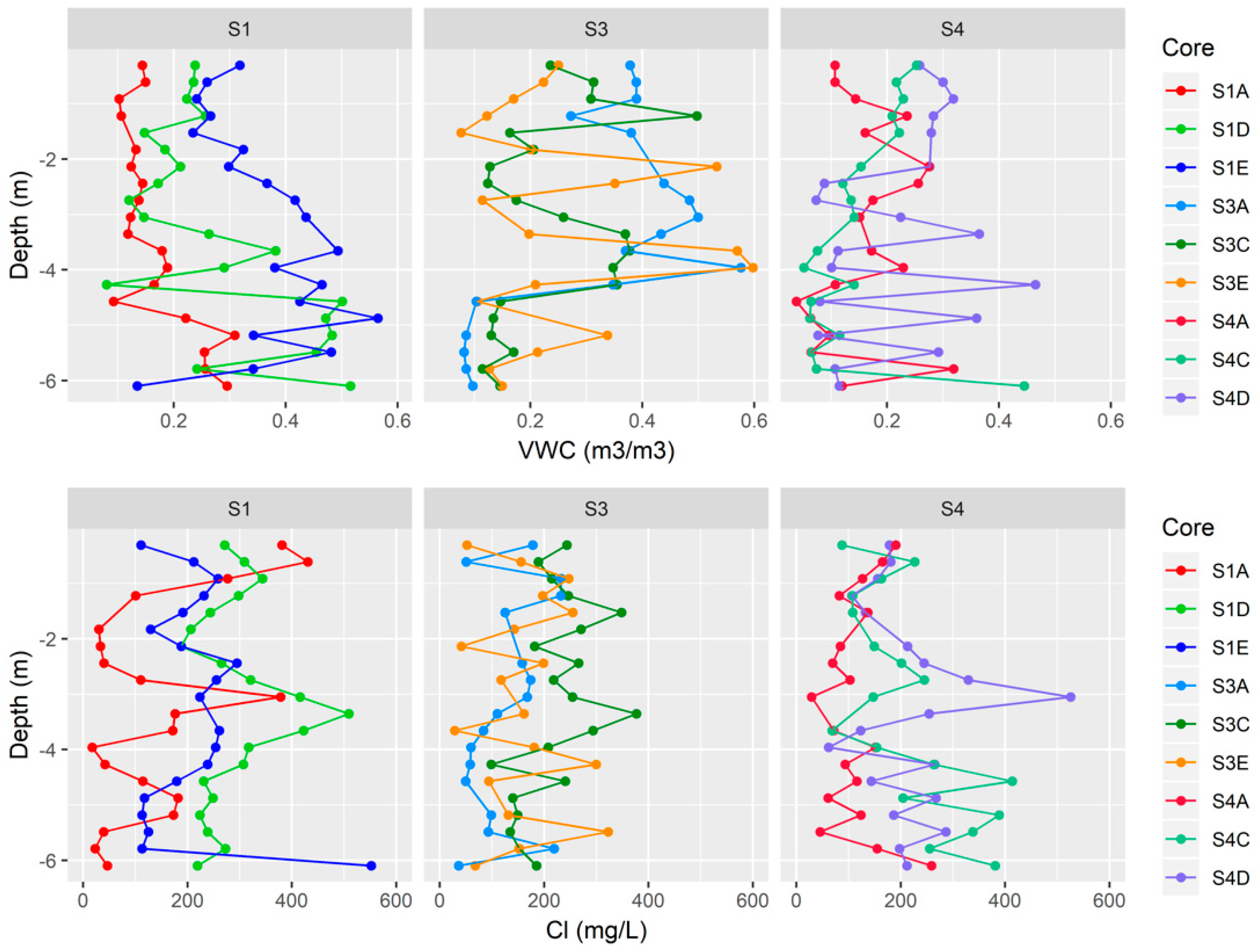


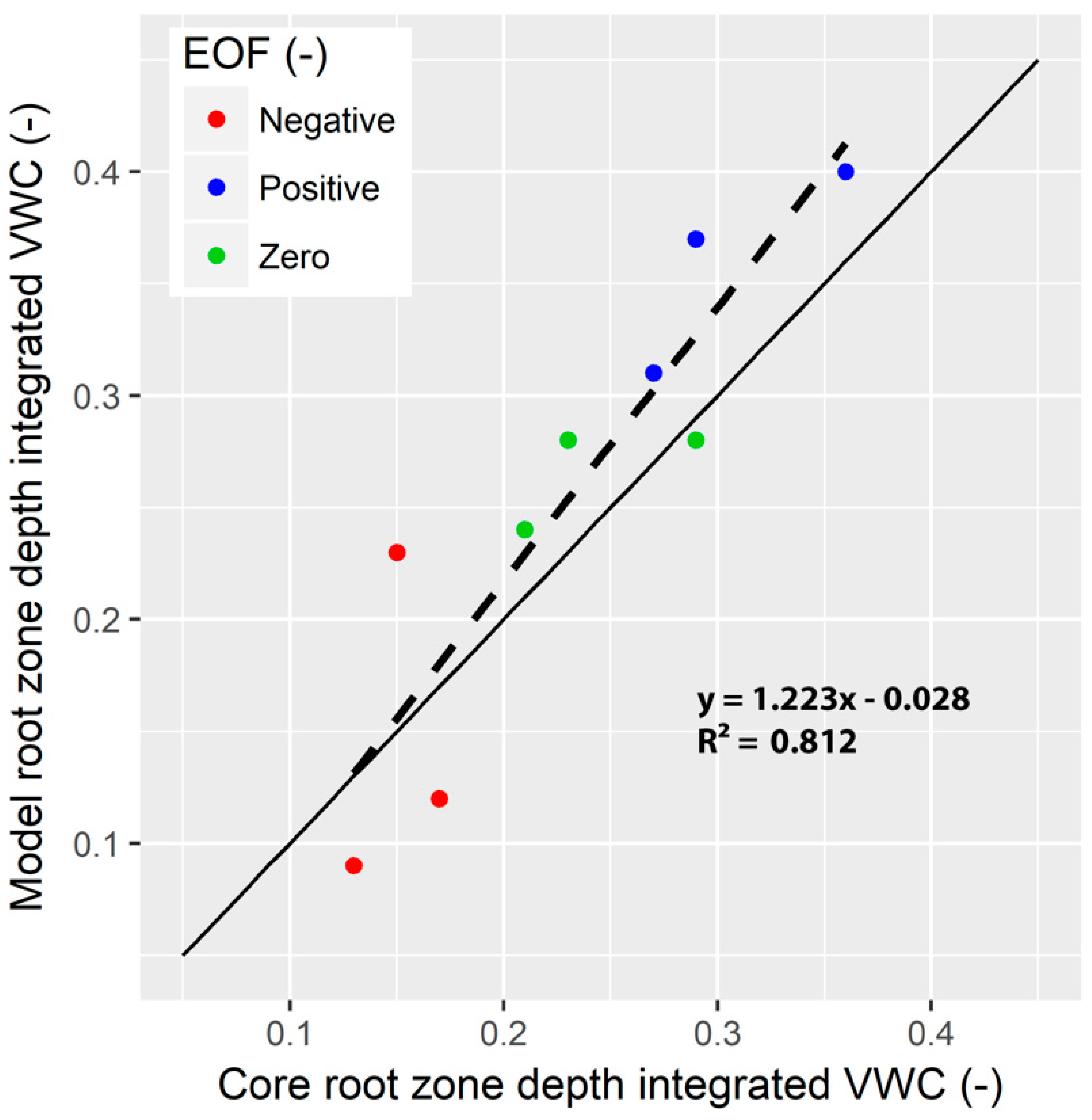
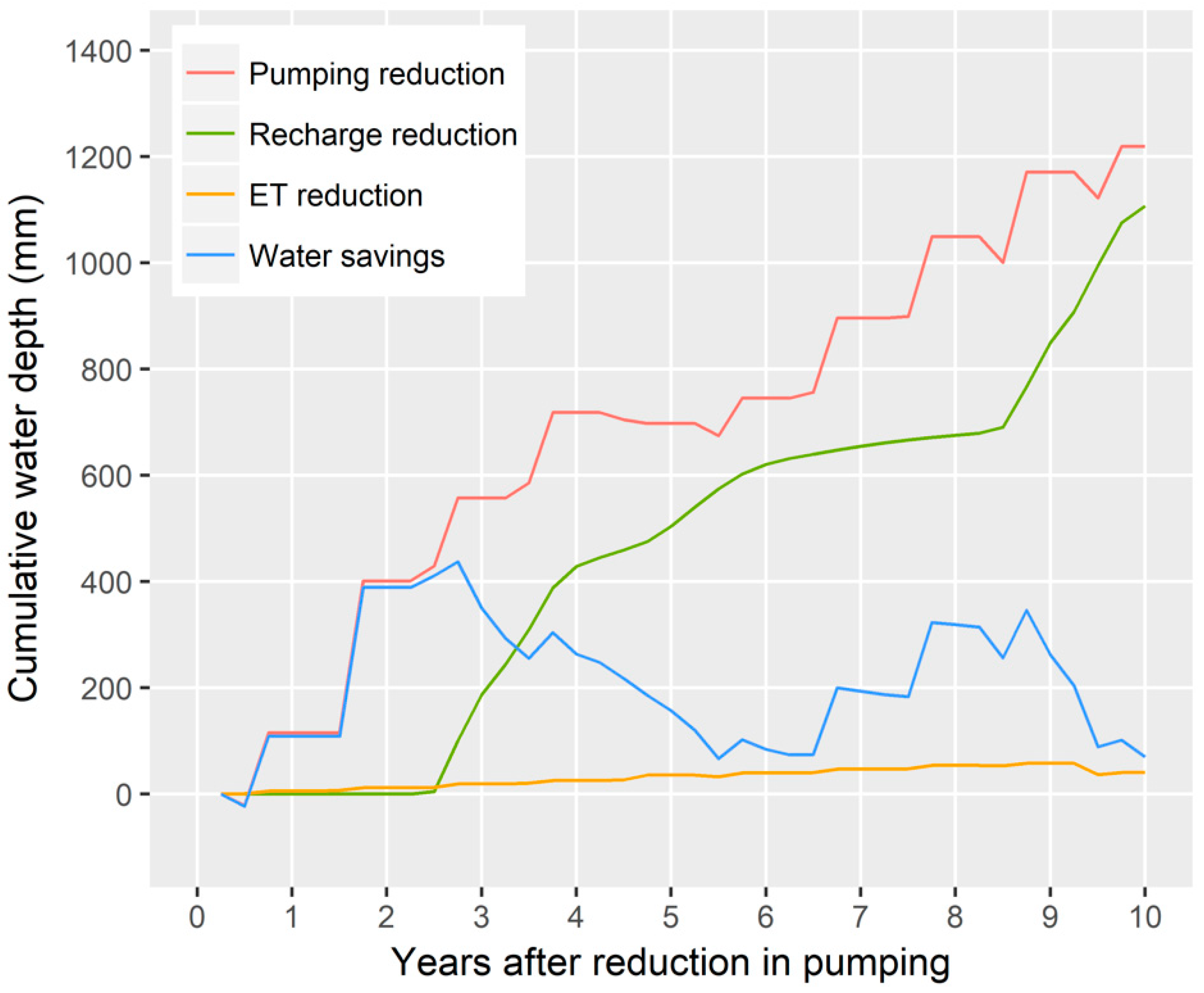
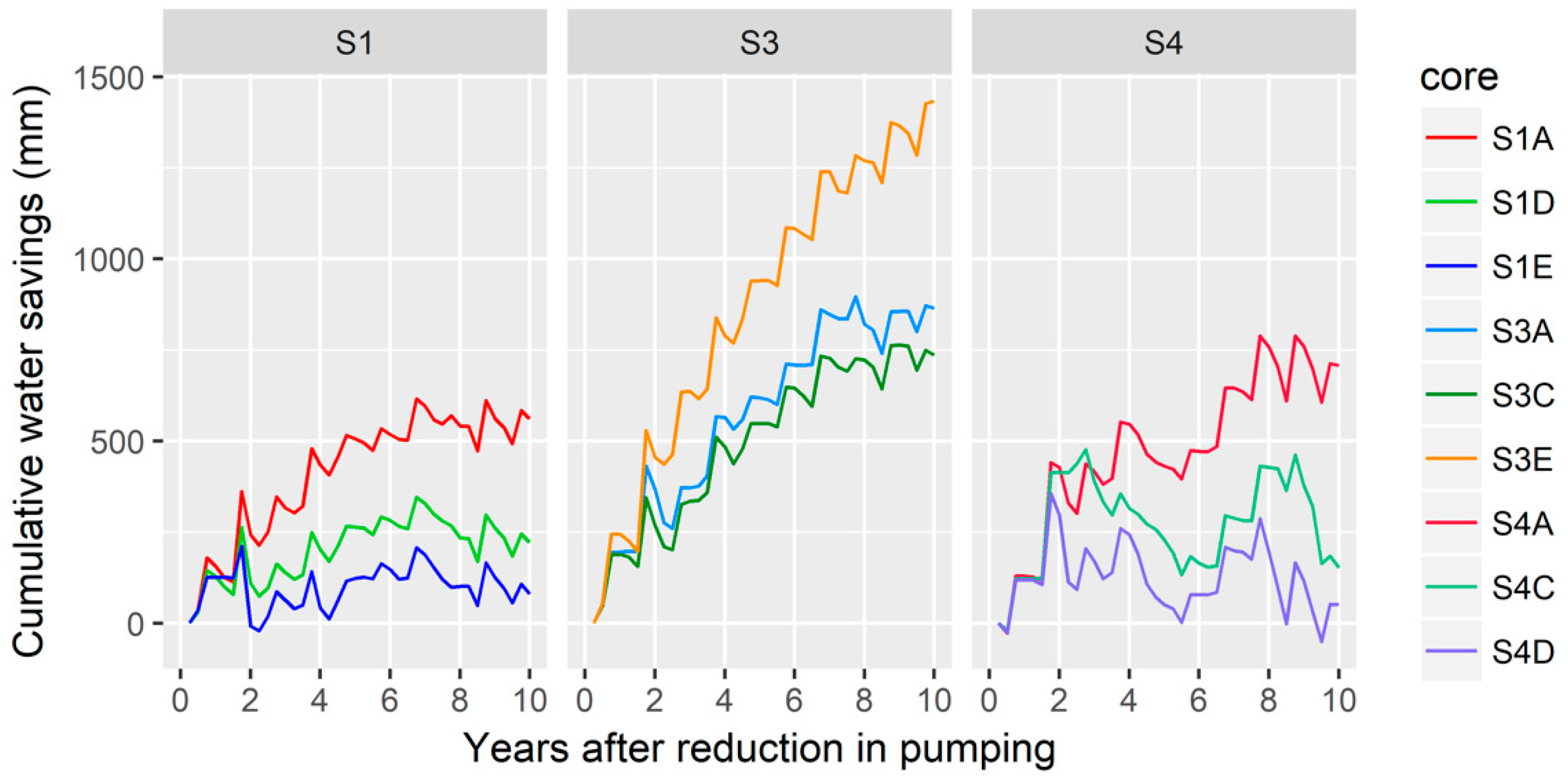
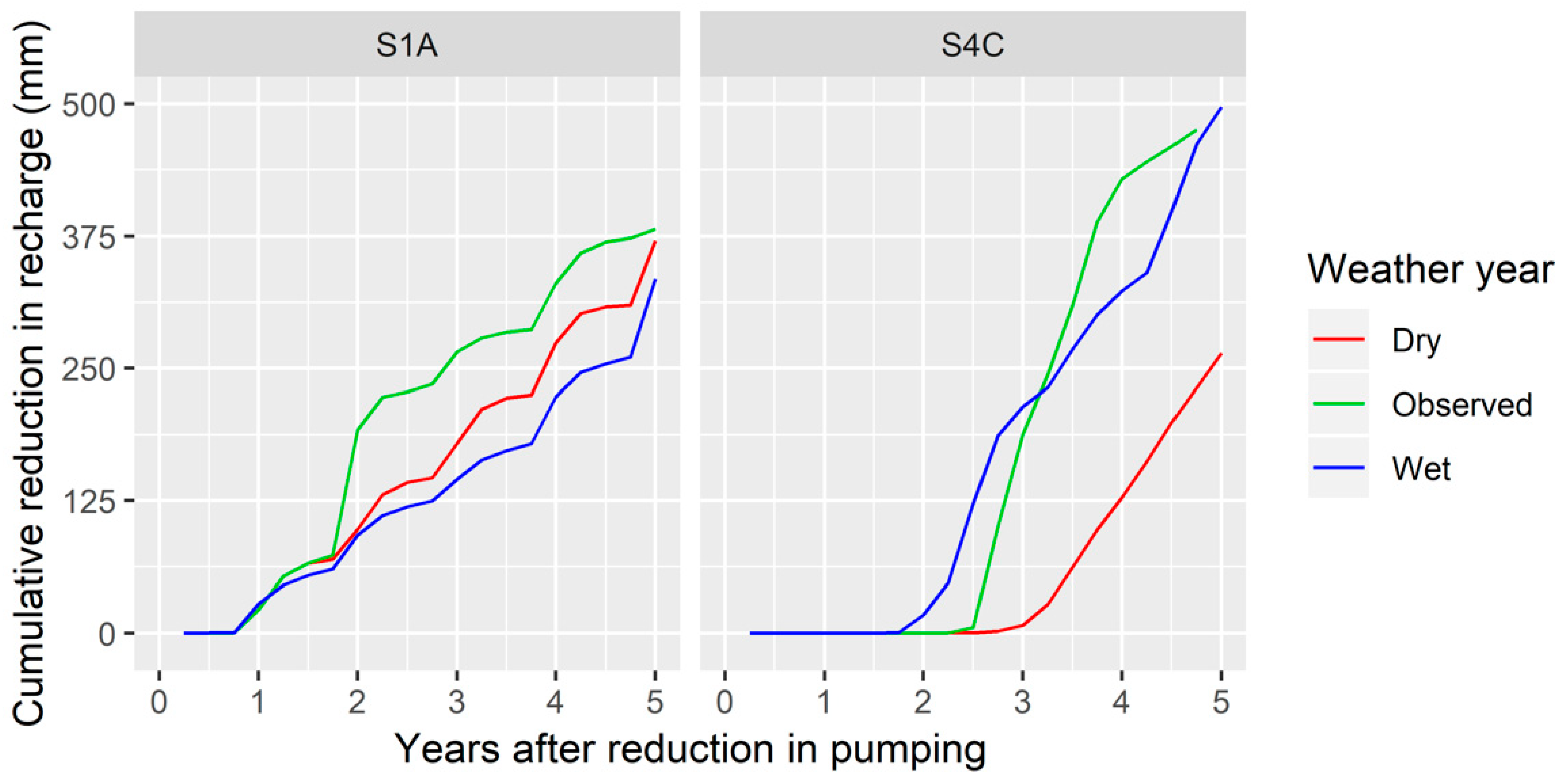
| Analysis/Methodology | Description |
|---|---|
| Geophysical surveys of field sites | Time-lapse electromagnetic induction and epithermal neutron intensity spatial mapping. Used to select 3 soil core sites with different soil texture. Spatial resolution is ~10 m. |
| Soil cores | 6 m cores extracted with geoprobe, cut into 30 cm sections and capped for storage for laboratory analysis. Gravimetric water content measured in laboratory. Gravimetric data are used to validate model simulations. Point measurement so may not be representative of field or geophysical area. |
| Soil hydraulic properties (θr, θs, n, α, Ksat) | Undisturbed soil cores extracted from 30 cm sections from geoprobe. Van Genuchten–Mualem parameters measured in laboratory using Hyprop, W4PC, and falling head tests on same core. Data from 3 instruments are used to fit to model with Hyprop software. Hydrus model results are highly sensitive to soil hydraulic properties especially n and α for unsaturated flow simulations. |
| Meteorological forcing (i.e., rainfall, air temp., air press., rel. hum., wind speed, ref. ET) | Hourly data provided by nearby Nebraska Mesonet station. Data are used to force the Hydrus and crop models. Nebraska Mesonet provides high quality data across the state used by many state and federal sources. Forcing data are highly sensitive on model results. |
| Irrigation | Some yearly totals provided by flow meter from producer. Irrigation values used to validate irrigation algorithm in Hydrus model. |
| Water table elevation | Static elevation provided by local ground water wells, used to justify free drainage lower boundary conditions at 6 m depth. Free drainage boundary condition should have a minimal impact on Hydrus model simulations. |
| Deep drainage | Directly measured with chloride mass balance approach. Used to validate Hydrus model simulations. |
| Crop yield | Provided by producer from combine data. Crop data are used as a proxy for annual ET and its year to year variation with weather conditions. For water limited crops, a linear relationship typically exists between ET and yield. |
| Crop model | Used to validate crop yield and variable root growth. Crop model results used in Hydrus simulations for partitioning E and T and root water uptake functions with depth. |
| Field Site | ECa Survey Dates | Explained Variance of 1st EOF (%) |
|---|---|---|
| S1 | 2016: 11 March 2017: 2 and 3 May | 96 |
| S3 | 2016: 11 March 2017: 2 and 3 May | 91 |
| S4 | 2016: 11 March 2017: 2 and 3 May | 69 |
| Field Site | ||||
|---|---|---|---|---|
| Irrigation Depth Summary | S1 | S3 | S4 | |
| Data source | Flow meter | 9 | - | - |
| Pivot telemetry | - | 2 | 3 | |
| Farmer record | - | 3 | 3 | |
| Number of years with data | 9 | 5 | 6 | |
| Average depth (mm) | 390 | 310 | 460 | |
| Depth to groundwater (m) | 6–8 | 6 | 16 | |
| Irrigation water summary | S1 | S3 | S4 | |
| Number of dates sampled over 2 growing seasons (2016 and 2017) | 5 | 3 | 5 | |
| Average Cl− (mg L−1) | 115 (2) | 121 (3) | 122 (3) | |
| Core | Depth (m) | (cm3 cm−3) | (cm3 cm−3) | n (-) | Ksat (cm day−1) | |
|---|---|---|---|---|---|---|
| S1A | 0.3 | 0.039 | 0.328 | 0.018 | 2.176 | 30.6 |
| S1A | 1.8 | 0 | 0.367 | 0.0158 | 1.644 | 391 |
| S1A | 3.4 | 0.054 | 0.399 | 0.0241 | 1.599 | 317 |
| S1A | 4 | 0.03 | 0.45 | 0.0132 | 1.486 | 110 |
| S1A | 5.2 | 0.044 | 0.547 | 0.0176 | 1.262 | 415 |
| S1A | 6.1 | 0 | 0.527 | 0.0517 | 1.182 | 7516 |
| S1D | 0.3 | 0.038 | 0.45 | 0.0087 | 1.433 | 5.8 |
| S1D | 1.2 | 0.037 | 0.438 | 0.0357 | 1.322 | 2191 |
| S1D | 2.1 | 0 | 0.452 | 0.0226 | 1.316 | 109.9 |
| S1D | 2.7 | 0.036 | 0.438 | 0.0235 | 1.608 | 102 |
| S1D | 3.4 | 0.038 | 0.495 | 0.0168 | 1.263 | 15.6 |
| S1D | 4.3 | 0.04 | 0.475 | 0.0035 | 1.399 | 0.5 |
| S1D | 5.8 | 0 | 0.36 | 0.0123 | 1.205 | 0.6 |
| S1E | 0.3 | 0 | 0.56 | 0.3303 | 1.135 | 10,000.0 * |
| S1E | 1.2 | 0.036 | 0.321 | 0.0136 | 1.491 | 36.1 |
| S1E | 1.8 | 0.059 | 0.398 | 0.0575 | 1.119 | 10.8 |
| S1E | 3 | 0.073 | 0.481 | 0.0232 | 1.213 | 15.6 |
| S1E | 4.6 | 0.061 | 0.432 | 0.0041 | 1.308 | 0.3 |
| S1E | 5.5 | 0.048 | 0.417 | 0.0046 | 1.378 | 1.5 |
| S3A | 0.3 | 0 | 0.499 | 0.0574 | 1.075 | 187.6 |
| S3A | 1.2 | 0 | 0.475 | 0.0127 | 1.42 | 333.3 |
| S3A | 1.5 | 0.048 | 0.593 | 0.0826 | 1.15 | 89.3 |
| S3A | 4 | 0.066 | 0.534 | 0.0518 | 1.079 | 207.8 |
| S3A | 4.3 | 0.042 | 0.469 | 0.0044 | 1.15 | 0.6 |
| S3A | 5.2 | 0.063 | 0.435 | 0.0372 | 1.847 | 40.1 |
| S3C | 0.3 | 0.063 | 0.41 | 0.0653 | 1.133 | 68 |
| S3C | 1.2 | 0.041 | 0.446 | 0.0999 | 1.203 | 1806.6 |
| S3C | 1.5 | 0 | 0.55 | 0.0389 | 1.379 | 177.2 |
| S3C | 2.7 | 0.043 | 0.356 | 0.0566 | 2.54 | 492 |
| S3C | 3.4 | 0.064 | 0.583 | 0.011 | 1.118 | 1.8 |
| S3C | 5.2 | 0.027 | 0.473 | 0.0525 | 3.564 | 464 |
| S3E | 0.3 | 0 | 0.306 | 0.0621 | 1.588 | 401.2 |
| S3E | 0.9 | 0.048 | 0.31 | 0.1201 | 1.535 | 1294 |
| S3E | 1.5 | 0.029 | 0.38 | 0.1034 | 1.86 | 10.4 |
| S3E | 2.4 | 0.027 | 0.436 | 0.0152 | 2.784 | 22.5 |
| S3E | 3.7 | 0 | 0.376 | 0.0197 | 1.19 | 0.9 |
| S3E | 4.3 | 0.036 | 0.432 | 0.0622 | 2.201 | 7 |
| S3E | 5.2 | 0.033 | 0.368 | 0.1029 | 1.556 | 39.8 |
| S3E | 6.1 | 0.032 | 0.387 | 0.0808 | 2.577 | 259 |
| S4A | 0.3 | 0.036 | 0.325 | 0.0131 | 2.561 | 592 |
| S4A | 1.2 | 0.054 | 0.422 | 0.0375 | 1.313 | 3478 |
| S4A | 2.4 | 0 | 0.499 | 0.0365 | 1.261 | 54 |
| S4A | 3.7 | 0.034 | 0.467 | 0.0336 | 1.391 | 521 |
| S4A | 4.6 | 0 | 0.297 | 0.3742 | 1.203 | 311 |
| S4A | 5.8 | 0.038 | 0.512 | 0.0116 | 1.316 | 52.5 |
| S4C | 0.3 | 0.081 | 0.545 | 0.0564 | 1.176 | 5025 |
| S4C | 1.2 | 0.028 | 0.533 | 0.2994 | 1.175 | 10,000.0 * |
| S4C | 1.8 | 0.027 | 0.459 | 0.0216 | 1.502 | 33.6 |
| S4C | 3.4 | 0.033 | 0.319 | 0.0228 | 1.736 | 21.7 |
| S4C | 4.3 | 0 | 0.345 | 0.2216 | 1.485 | 6436 |
| S4C | 5.5 | 0 | 0.407 | 0.0475 | 1.375 | 7.8 |
| S4C | 6.1 | 0 | 0.402 | 0.0378 | 1.562 | 29.5 |
| S4D | 0.3 | 0.033 | 0.522 | 0.1255 | 1.162 | 7635.8 |
| S4D | 1.2 | 0.016 | 0.462 | 0.0198 | 1.279 | 5.7 |
| S4D | 2.1 | 0.028 | 0.372 | 0.0157 | 2.012 | 59.5 |
| S4D | 3.7 | 0.03 | 0.399 | 0.0191 | 2.105 | 353.4 |
| S4D | 4 | 0.047 | 0.344 | 0.0249 | 3.217 | 1261 |
| S4D | 5.2 | 0 | 0.333 | 0.063 | 1.954 | 36.7 |
| S4D | 5.8 | 0 | 0.422 | 0.017 | 2.646 | 321 |
| Core | Deep Drainage (mm yr−1) | % of CMB | Pumping Depths (mm yr−1) | % of Observed | Total Stored Years of Cl− | NO3-N Leaching (kg ha−1 yr−1) | ||
|---|---|---|---|---|---|---|---|---|
| CMB | Model | Observed | Modeled | |||||
| S1A | 435 | 336 | 77 | 390 | 427 (H) | 110 | 3 | 39 |
| S1D | 135 | 148 | 110 | 7 | 8 | |||
| S1E | 187 | 163 | 87 | 7 | 18 | |||
| S3A * | 321 | 117 | 36 | 310 | 304 (H) | 98 | 5 | 12 |
| S3C | 166 | 131 | 79 | 9 | 3 | |||
| S3E | 271 | 216 | 80 | 5 | 10 | |||
| S4A | 515 | 384 | 75 | 460 | 420 (H) | 91 | 2 | 21 |
| S4C | 205 | 180 | 88 | 3 | 18 | |||
| S4D | 215 | 181 | 84 | 5 | 13 | |||
| Mean | 272 | 206 | 80 | - | - | 100 | 5 | 16 |
| Median | 215 | 180 | - | - | - | - | - | 13 |
| Yield at Core Location (Mg ha−1) | |||||
|---|---|---|---|---|---|
| Field Site | Year | Crop | S1A | S1D | S1E |
| S1 | 2015 | Soybean | 2.1 | 4.0 | 4.3 |
| 2016 | Maize | 9.7 | 12.9 | - | |
| 2017 | Maize | 7.4 | 10.8 | 13.2 | |
| S4A | S4C | S4D | |||
| S4 | 2016 | Soybean | 3.9 | 5.9 | 5.9 |
| 2017 | Maize | 10.0 | 14.0 | 14.6 | |
Disclaimer/Publisher’s Note: The statements, opinions and data contained in all publications are solely those of the individual author(s) and contributor(s) and not of MDPI and/or the editor(s). MDPI and/or the editor(s) disclaim responsibility for any injury to people or property resulting from any ideas, methods, instructions or products referred to in the content. |
© 2024 by the authors. Licensee MDPI, Basel, Switzerland. This article is an open access article distributed under the terms and conditions of the Creative Commons Attribution (CC BY) license (https://creativecommons.org/licenses/by/4.0/).
Share and Cite
Gibson, J.; Franz, T.E.; Gilmore, T.; Heeren, D.; Gates, J.; Thomas, S.; Neale, C.M.U. Groundwater Recharge Response to Reduced Irrigation Pumping: Checkbook Irrigation and the Water Savings Payment Plan. Water 2024, 16, 2910. https://doi.org/10.3390/w16202910
Gibson J, Franz TE, Gilmore T, Heeren D, Gates J, Thomas S, Neale CMU. Groundwater Recharge Response to Reduced Irrigation Pumping: Checkbook Irrigation and the Water Savings Payment Plan. Water. 2024; 16(20):2910. https://doi.org/10.3390/w16202910
Chicago/Turabian StyleGibson, Justin, Trenton E. Franz, Troy Gilmore, Derek Heeren, John Gates, Steve Thomas, and Christopher M. U. Neale. 2024. "Groundwater Recharge Response to Reduced Irrigation Pumping: Checkbook Irrigation and the Water Savings Payment Plan" Water 16, no. 20: 2910. https://doi.org/10.3390/w16202910
APA StyleGibson, J., Franz, T. E., Gilmore, T., Heeren, D., Gates, J., Thomas, S., & Neale, C. M. U. (2024). Groundwater Recharge Response to Reduced Irrigation Pumping: Checkbook Irrigation and the Water Savings Payment Plan. Water, 16(20), 2910. https://doi.org/10.3390/w16202910







